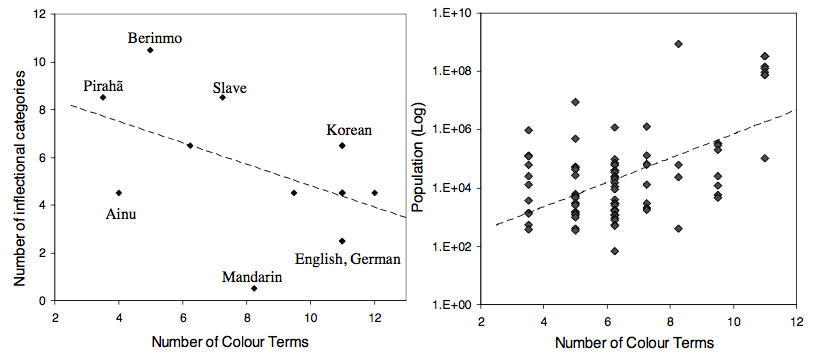Continuing my series on the Evolution of Colour terms, this post reviews how learning constrains colour naming. For the full dissertation and for references, go here.
Memory and learning mechanisms are necessary to acquire colour categories (Komarova, Jameson & Narens, 2007). Models have shown that individual learning alone does not lead to categorisations that are shared within a population, suggesting that individual learning is a weak constraint: Steels & Belpaeme (2005) ran a model where agents could change their colour categories over a lifetime through individual learning. The agents were successful at the discrimination game, but the systems did not become shared between agents or between populations.
Learning constraints also include storage capacity. However, the number of categories for colours is not typically larger than any other domain, and Tzotsil speakers seem to be able to acquire hundreds of grammaticalised forms (MacKeigan & Muth, 2006).
Lupyan and Dale (2010) hypothesise that languages spoken by larger, more dispersed groups (e.g., English) favour less morphological complexity (more lexicalised meanings). This is because more dispersed languages may be adapted to greater numbers of adult non- native speakers, who find it easier to learn ‘simpler’ morphology. Furthermore, contextually restricted terms for colour are more feasible to use in tighter-knit communities. For example, a speaker of Tzotszil, living in a remote village in Mexico described a pink Munsell chip with the name of a flower and the location of the particular flower they hand in mind (MacKeigan & Muth, 2006). This approach is not feasible in a large, dispersed community. The figure below shows the current study’s finding that more basic colour terms are found in larger groups (r=0.35, df=87, p<.005) and in ‘simpler’ languages with fewer inflectional forms for verbs (r= -0.51, df=14, p=.04, raw data from Kay & Maffi, 2009, The Ethnologue – Lewis, 2009, Roberson, Davies, Corbett, & Vandervyver, 2005).

This fits with Lupyan & Dale’s hypothesis as well as with Embodied Cognition’s emphasis on the functional role of language. It also predicts that, although cultural processes may synchronise perceptions, there will be less synchronisation in more dispersed language communities.
KOMAROVA, N., JAMESON, K., & NARENS, L. (2007). Evolutionary models of color categorization based on discrimination Journal of Mathematical Psychology, 51 (6), 359-382 DOI: 10.1016/j.jmp.2007.06.001
Steels, L., & Belpaeme, T. (2005). Coordinating perceptually grounded categories through language: A case study for colour Behavioral and Brain Sciences, 28 (04) DOI: 10.1017/S0140525X05000087
Lupyan G, & Dale R (2010). Language structure is partly determined by social structure. PloS one, 5 (1) PMID: 20098492
Roberson, D., Davies, I., Corbett, G., & Vandervyver, M. (2005). Free-Sorting of Colors Across Cultures: Are there Universal Grounds for Grouping? Journal of Cognition and Culture, 5 (3), 349-386 DOI: 10.1163/156853705774648536
